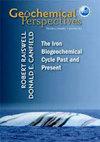未来全球矿产资源
IF 2.5
3区 地球科学
Q1 GEOCHEMISTRY & GEOPHYSICS
引用次数: 113
摘要
一些科学家和记者,以及许多公众,已经被引导相信,世界正在迅速耗尽我们现代社会所依赖的金属。几十年来,峰值金属概念的倡导者一直预测,消费的增加将很快导致矿产资源的枯竭。然而,尽管生产和消费不断增加,但矿产供应仍能满足工业和社会的需求,储量的使用寿命与30-40年前相似。在本卷中,我们利用我们在矿产行业学术和工业方面的丰富经验和专业知识,讨论了这种明显矛盾的原因。许多误解源于对全球矿产资源规模的错误估计,这些估计源于对储量和资源之间的关键差异缺乏了解。一些作者在预测即将出现的短缺时,使用了报价储量——即目前已证明存在且对采矿经济的金属量。资源——地壳上部几公里内可能获得的数量——要大得多。在过去的150年里,技术的改进、规模经济和效率的提高共同降低了成本,从而使低品位矿石得以经济开采。最终结果是,大多数金属经通胀调整后的长期价格在产量增加的同时或多或少地下降了,这是第二个明显的悖论,但人们往往不太了解。以铜为主要例子,并酌情使用其他金属,我们总结了有关矿床和矿产行业活动的最新研究。在描述了形成矿床的众多地质过程之后,我们概述了矿产工业勘探新矿床所使用的科学方法。我们还讨论了如何开采资源和如何加工矿物,以及最近为减少相关环境影响所做的努力。经济和社会因素影响供应,这些因素与资源的实际存在同等重要。最后,我们讨论了地球科学家在确保矿产持续供应方面将发挥的关键作用。其中包括开发有助于矿产资源发现、开采、加工、修复和管理的新概念和技术。研究人员必须帮助教育公众,让他们认识到需要继续探索,以寻找新的资源来满足世界生活水平的增长。我们证明,全球铜资源,可能还有大多数其他金属的资源,比目前大多数可用的估计要大得多,特别是如果效率的提高和价格的上涨允许开采品位较低的矿石。这些观察结果表明,在可预见的未来,重要矿物商品的供应仍将充足。本文章由计算机程序翻译,如有差异,请以英文原文为准。
Future Global Mineral Resources
Some scientists and journalists, and many members of the general public, have been led to believe that the world is rapidly running out of the metals on which our modern society is based. Advocates of the peak metal concept have predicted for many decades that increasing consumption will soon lead to exhaustion of mineral resources. Yet, despite ever-increasing production and consumption, supplies of minerals have continued to meet the needs of industry and society, and lifetimes of reserves remain similar to what they were 30–40 years ago. In this volume, we discuss the reasons for this apparent paradox using our broad experience and expertise on both academic and industrial sides of the minerals sector. Many misconceptions arise from flawed estimates of the size of global mineral resources which stem from a lack of understanding of the critical difference between reserves and resources. Some authors use quoted reserves – the amount of metal proven to exist and to be economic for mining at present – when predicting imminent shortages. Resources – the amount that may be accessible in the upper few kilometres of the crust – are far larger. Over the last 150 years, improved technologies, economies of scale and increased efficiency have combined to reduce costs hence allowing lower-grade ore to be mined economically. The net result is that the long-term inflation-adjusted price of most metals has decreased more or less in parallel with increasing production, a second apparent paradox that frequently is not well understood. Using copper as the principal example and other metals as appropriate, we summarise the latest research on ore deposits and the activities of the minerals industry. Following a description of the numerous geological processes that form ore deposits, we outline the scientific methods used by the minerals industry to explore for new deposits. We also discuss how resources are mined and how minerals are processed, as well as recent efforts to reduce related environmental impacts. Economic and societal factors influence supply, and these are as important as the actual presence of a resource. Finally, we discuss the critical roles that geoscientists will play in assuring continued supplies of minerals. These include the development of new concepts and techniques that will assist the discovery, mining, processing, remediation, and management of mineral resources. It is essential that researchers help to educate the general public about the need for continued exploration to find new resources to meet growth in world living standards. We demonstrate that global resources of copper, and probably of most other metals, are much larger than most currently available estimates, especially if increasing efficiencies and higher prices allow lower-grade ores to be mined. These observations indicate that supplies of important mineral commodities will remain adequate for the foreseeable future.
求助全文
通过发布文献求助,成功后即可免费获取论文全文。
去求助
来源期刊

Geochemical Perspectives
GEOCHEMISTRY & GEOPHYSICS-
CiteScore
0.80
自引率
0.00%
发文量
1
期刊介绍:
Each issue of Geochemical Perspectives presents a single article with an in-depth view on the past, present and future of a field of geochemistry, seen through the eyes of a highly respected member of our community. The articles combine science and history of the field’s development and the scientist’s opinions about future directions. We expect personal glimpses into the author’s scientific life, how ideas were generated, pitfalls and triumphs along the way, and how ideas were adopted to carry our field further. Perspectives articles are intended for the entire geochemical community, not for experts. They are not reviews or monographs or text books. They go beyond the current state of the art, providing opinions about future directions and impact in the field.
 求助内容:
求助内容: 应助结果提醒方式:
应助结果提醒方式:


